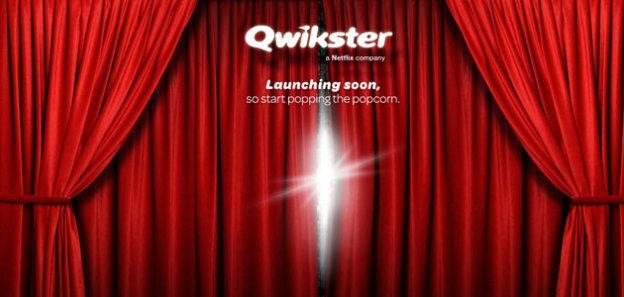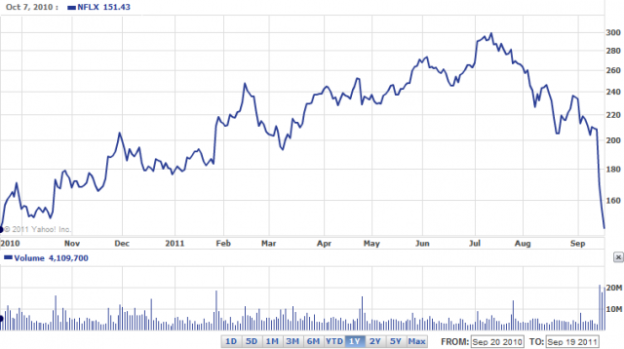
Well, that was “qwik:” a scant three weeks after announcing it was spinning off its DVD rental business as the horribly-named Qwikster, Netflix CEO Reed Hastings has sent word down from on high: Qwikster will never be born, and Netflix will keep its streaming and DVD rental businesses unified. Customers will continue to be able to manage streaming and DVD rentals from a single account on a single Web site, with unified reviews, recommendations, accounts, and billing. However, those bills won’t be changing: the price hikes last July that saw some Netflix customers’ bills increase by as much as 60 percent for the same service will remain in effect. It’s not yet clear what will happen with Qwikster’s promise of rent-by-mail video games.
Announcing Qwikster, Netflix CEO Reed Hastings noted “companies rarely die from moving too fast, and they frequently die from moving too slowly.” However, Netflix’s rapid re-alignments are taking a toll on both customers’ and investors’ patience — not to mention its stock price. Can Netflix survive all these flip-flops? And what about the market pressures that led Netflix to try to spin off its DVD business in the first place?
The damages done
Before Netflix announced it was spinning off Qwikster, the company admitted (PDF) it believed it would lose about a million U.S. customers in the wake of its July price hikes: about 800,000 from its DVD rental service and 200,000 from its streaming service. A million customers seems like a huge number, but that’s not really true for Netflix: it claims to have had 37 million customers before the price changes, and expected to have 36 million once the smoke cleared. That’s an estimated loss of less than three percent in the U.S. market.
Netflix said it planned to use increased revenue from its price hike to build up its streaming service, primarily by licensing more streaming content. What Netflix failed to realize, it seems, is that the price hikes and Qwikster spinoff would repeatedly aggravate U.S. subscribers who receive both DVD rentals and streaming service. How many is that? Netflix expected the number of customers who subscribed to both streaming and DVD rentals would remain about the same after the price hike: 12 million, or roughly one third of its total subscribers. That means Netflix’s announcements translate to 12 million customers who feel screwed over with bait-and-switch pricing, then got nailed again when Netflix decided to make it more difficult to receive the same services for those just-increased prices.
Netflix gambled that, even if irritated, fewer than one in ten of those 12 million customers would leave the service—essentially because they have few alternatives. (There are some: Apple iTunes, Amazon Prime, Hulu Plus, Redbox, and CinemaNow for starters.) Netflix did not think the price shift would have a measurable impact on the company’s overall revenues, thanks to Netflix rolling out streaming service in a variety of international markets, including Brazil and dozens of other Latin American and Caribbean countries. Netflix streaming is also operating in Canada. The loss of domestic U.S. customers would be offset by streaming customers from international markets.
However, Netflix’s decisions have had a mammoth impact on the company’s stock price and public perception. Netflix stock was trading at $298.73 a share on July 13, the day it announced its price hikes. On Friday, October 7, the stock closed at $117.21 — a loss of almost 61 percent. Netflix’s market capitalization Friday was just over $6.1 billion; back in July, it was well over $15 billion.

If Netflix’s estimates of the impact of the price hike on its subscriber base hold up — we should find out at the end of the month when the company releases its Q3 financials — then Netflix’s stock price woes would be purely related to the price hike and the Qwikster announcement, and have little to do with shifts in the company’s revenue or subscriber base. In other words, it would all be about investors’ perception of the company, rather than its actual revenue or subscriber figures. The flip-flop on Qwikster may satisfy some consumers, but it’s not going to help customers’ or investors’ perceptions of Netflix’s leadership: This week, they come across as even more out-of-touch and reactive than last week.
A victory for consumer backlash?

Netflix may be killing Qwikster, but it is not rolling back its July price hikes. (“We are now done with price changes,” Hastings wrote in his “extra-communicative” 60-word dispatching of Qwikster.) Assuming again that Netflix’s estimates of U.S. subscriber changes play out, the company will have successfully converted about 12 million people from paying $9.99 a month for streaming service plus one-DVD-at-a-time via mail to paying $15.98 for the same service. Back-of-the-envelope math indicates Netflix would be reaping another $72 million per month from those increased fees, or over $860 million per year, even if the company never added another subscriber to its DVD rental service. That hardly seems like a consumer victory.
What about the reasons Netflix felt it needed to spin out the DVD business? Many industry watchers felt spinning out Qwikster was a way to prep itself for sale, or at least make itself more attractive to investors. Jettison the costly, labor-intensive DVD-by-mail business — which has faced growing difficulties with studios and rising operational costs — in favor of the streaming business, which has far more controllable costs and can operate in a myriad of international markets, not just the United States.
Keeping the DVD business in-house means Netflix will continue to be saddled with its costs, including warehousing, fuel, labor, shipping and postage, plus tracking and stocking all that media. Although flying a 747 full of DVDs might still be the fastest way to deliver oodles of data across the country (in terms of sheer bandwidth, anyway), using fossil fuels, warehouses, sorting machines, and manual labor to deliver digital data to homes a few gigabytes at a time is a losing proposition in the long term, especially as broadband Internet penetrates more deeply into rural and under-serviced areas as well as developing international markets. Netflix has always realized that. The company isn’t called “Netflix” because customers can manage an account via the Web: It’s because the DVD rental business was always a stopgap until the company was able to deliver all its content via the Internet.
Think global, act global
Keeping the DVD business also means the touted future benefits of spinning off Qwikster will not materialize. Netflix CEO Reed Hastings has said his “greatest fear” is that Netflix would not be able to transition from the DVD rentals to streaming, and has noted repeatedly that the streaming business has a substantially different cost structure than DVD rentals. The company feels the two services need to be developed and marketed separately.

Why? A great deal of Hastings’ “greatest fear” has to do with Netflix’s global ambitions for its streaming business. Remember that the company’s DVD rental business is U.S.-only: in Canada, Brazil, and Latin America, Netflix is only a streaming company. In those markets, the Netflix catalog isn’t littered with tens of thousands of DVD titles that aren’t available for streaming. Netflix has no interest in getting into DVD rentals in international markets. However, it is very interested in setting up licensing deals for streaming content from international partners—and a lot of that content will likely only be available in selected markets.
Back in the United States, Netflix feels that having its DVD service “meshed” with its streaming service is a significant impediment. By keeping the operations entwined, Netflix’s biggest market for streaming content — currently the United States — has to be operated in a completely different way from international markets. Right now, the international markets are the small-potatoes exceptions to Netflix’s business model, but remember that Netflix wants to be a streaming-only company. Over time, Netflix doesn’t want the U.S. market to be a unique, cost-intensive exception to its global operations. To maximize efficiency, Netflix’s U.S. streaming market should pave the way for international markets, not operate on completely separate principles. And that means severing the DVD rental operations sooner rather than later, or at least removing its operational burden.
How to move forward?
If Netflix plans to stick to its vision of being a streaming-only company — and it does — it will eventually sell or shut down its DVD business. Since U.S. customers obviously won’t accept that that yet, Netflix’s medium-term path would seem to be:
- Continue operating the DVD rentals business “as is” while encouraging customers to migrate to streaming services. The most likely ways will be through more fee increases, like passing along increased costs from postage, and reduced availability of new content. Movies and TV programming that available “streaming-first” will encourage customers to migrate to streaming-only plans. Netflix will likely also stop marketing its DVD service.
- Invest part of the revenue from price hikes into increasing the efficiency of the DVD rental business (which Netflix had planned to do anyway), and look at ways to adapt the multi-service model in the United States to international markets. It won’t likely take the form of physical rentals, but it could take the form of through tiered services for premium content.
The Achilles’ Heel of Netflix’s U.S. business is the depth of content it offers on DVD. By getting first into the DVD business, Netflix set consumers’ expectations that, generally, anything available on DVD could be rented via Netflix. (And remember: What’s available on DVD is only a small portion of film and television content.) The streaming video business will not reach anything approaching that level for many years, perhaps a decade or more. Unfortunately for Netflix, the pace at which Netflix can convert DVD customers who expect to be able to access a vast library of content to streaming-only service is not entirely under its control. Where Netflix can legally offer anything sold on DVD for rental, streaming rights have to be negotiated separately — and networks and studios are going to play hardball for those licenses. Netflix may desperately want to leave DVDs behind, but its customers — and the movie and television businesses — just aren’t ready.


